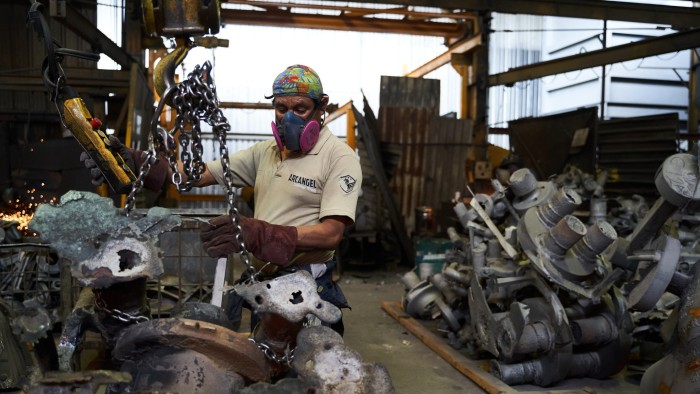Unlock the White House Watch newsletter for free
Your guide to what the 2024 US election means for Washington and the world
Traders in the US are paying much higher prices for copper, aluminium and steel than their European counterparts as they rush to buy the metals ahead of President Donald Trump’s tariffs.
Trump on Sunday said he would impose 25 per cent tariffs on all steel and aluminium imports. He has also threatened to apply levies on imported copper.
The looming tariffs have created an unusually wide transatlantic price gap, with the premium for benchmark New York Comex copper futures widening to more than $800 a tonne over the London price, the highest level since at least early 2020. Comex copper on Monday was up 2 per cent at just over $10,000 a tonne.
The high US premiums reflect a “distorted” market, said Tom Price, an analyst at Panmure Liberum, reflecting fears about a “starvation of supply” rather than the more usual reason of increased demand.
“The US can’t switch to any other source in the short term,” he said, noting this is particularly the case for aluminium. Buyers there are “competing with each other to get hold of the metal”.

Higher US premiums are a reflection of “the expectation that prices will be higher in future as a result of tariffs”, said Daria Efanova, head of research at Sucden Financial. “Markets are pricing that before it actually hits.”
Concerns over tariffs are rippling through the American aluminium market, sending a closely-tracked measure of the difference in US and London prices for the metal, called the Midwest premium, rising sharply.
The premium, which tracks prices of the metal delivered to plants in the US Midwest including taxes, transportation and other costs, is an important metric because the country relies on imports for about 80 per cent of its aluminium needs, according to JPMorgan. Canada is by far the US’s biggest source of refined aluminium, which is used widely in industry, from everything to cars and packaging.
Futures following the Midwest premium for settlement next month jumped nearly 10 per cent on Monday to 30 cents a pound, according to CME Group data.
US stocks of aluminium could provide a short-term “buffer” against a temporary supply crunch, JPMorgan noted. However, the Wall Street bank said if tariffs on all countries are implemented, the premium could jump more than a third to 40 cents as inventories will be “exhausted relatively quickly”.
Trump was expected to give more details about the prospective tariffs later on Monday, potentially including whether there might be any exemptions, as were granted when he levied tariffs on metals in his first term as president.
After his previous U-turns on tariffs against Canada and Mexico, analysts say many traders are waiting for more clarity, with some avoiding taking positions until the policies become clearer.
“The uncertainty creates a skittishness,” said Al Munro, an analyst at Marex. “It creates a lack of investment. You just sit there and you don’t do anything.”
Copper is widely used in electrical equipment such as wiring and motors, while aluminium is a lightweight material used in an array of industries including the automotive and aerospace sectors.

Copper is taken into Comex warehouses on a so-called “duty paid” basis, meaning all taxes must be paid before the metal enters the facilities. That means supplies taken in before tariffs come into effect would not be affected by the levies.
Comex’s stocks of copper jumped last year and have edged up further this year. “People are looking to protect against having to pay copper price plus tariff,” said William Adams, head of base metals research at Fastmarkets.
Traders rushing to secure access to physical metals ahead of any potential tariffs have pushed up premiums in the US for steel and precious metals such as silver and gold.
The potential tariffs on steel and aluminium are likely to have a particularly big impact on Canadian aluminium smelters, which supply about 44 per cent of US aluminium needs.


